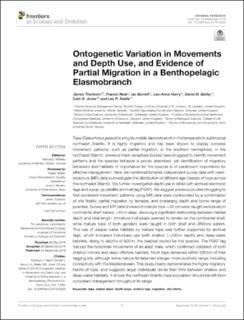| dc.contributor.author | Thorburn, James | |
| dc.contributor.author | Neat, Francis | |
| dc.contributor.author | Burrett, Ian | |
| dc.contributor.author | Henry, Lea-Anne | |
| dc.contributor.author | Bailey, David M. | |
| dc.contributor.author | Jones, Cath S. | |
| dc.contributor.author | Noble, Leslie Robert | |
| dc.date.accessioned | 2020-05-28T10:44:00Z | |
| dc.date.available | 2020-05-28T10:44:00Z | |
| dc.date.created | 2020-03-12T20:48:23Z | |
| dc.date.issued | 2019 | |
| dc.identifier.citation | Thorburn, J., Neat, F., Burrett, I., Henry, L.-A., Bailey, D. M., Jones, C. S. & Noble, L. R. (2019). Ontogenetic variation in movements and depth use, and evidence of partial migration in a benthopelagic elasmobranch. Frontiers in Ecology and Evolution, 7: 353. doi: | en_US |
| dc.identifier.issn | 2296-701X | |
| dc.identifier.uri | https://hdl.handle.net/11250/2655911 | |
| dc.description.abstract | Tope (Galeorhinus galeus) is a highly mobile elasmobranch in the temperate to subtropical northeast Atlantic. It is highly migratory and has been shown to display complex movement patterns, such as partial migration, in the southern hemisphere. In the northeast Atlantic, previous mark-recapture studies have struggled to identify movement patterns and the species behavior is poorly described, yet identification of migratory behaviors and habitats of importance for the species is of paramount importance for effective management. Here, we combined fisheries independent survey data with mark-recapture (MR) data to investigate the distribution of different age classes of tope across the northeast Atlantic. We further investigated depth use in detail with archival electronic tags and a pop-up satellite archival tag (PSAT). We suggest previous studies struggling to find consistent movement patterns using MR data were confounded by a combination of site fidelity, partial migration by females, and increasing depth and home range of juveniles. Survey and MR data showed immature tope <40 cm were caught exclusively in continental shelf waters <45 m deep, showing a significant relationship between habitat depth and total length. Immature individuals seemed to remain on the continental shelf, while mature tope of both genders were caught in both shelf and offshore waters. This use of deeper water habitats by mature tope was further supported by archival tags, which indicated individuals use both shallow (<200 m depth) and deep-water habitats, diving to depths of 826 m; the deepest record for this species. The PSAT tag tracked the horizontal movements of an adult male, which confirmed utilization of both shallow inshore and deep offshore habitats. Most tope remained within 500 km of their tagging site, although some mature females had a larger, more southerly range, including connectivity with the Mediterranean. This study clearly demonstrates the highly migratory habits of tope, and suggests larger individuals divide their time between shallow and deep-water habitats. It shows the northeast Atlantic tope population should benefit from consistent management throughout its range. | en_US |
| dc.language.iso | eng | en_US |
| dc.publisher | Frontiers | en_US |
| dc.rights | Navngivelse 4.0 Internasjonal | * |
| dc.rights.uri | http://creativecommons.org/licenses/by/4.0/deed.no | * |
| dc.title | Ontogenetic variation in movements and depth use, and evidence of partial migration in a benthopelagic elasmobranch | en_US |
| dc.type | Peer reviewed | en_US |
| dc.type | Journal article | en_US |
| dc.description.version | publishedVersion | en_US |
| dc.rights.holder | © 2019 The Author(s) | en_US |
| dc.subject.nsi | VDP::Matematikk og Naturvitenskap: 400::Zoologiske og botaniske fag: 480::Marinbiologi: 497 | en_US |
| dc.subject.nsi | VDP::Matematikk og Naturvitenskap: 400::Zoologiske og botaniske fag: 480::Etologi: 485 | en_US |
| dc.source.pagenumber | 14 | en_US |
| dc.source.volume | 7 | en_US |
| dc.source.journal | Frontiers in Ecology and Evolution | en_US |
| dc.identifier.doi | 10.3389/fevo.2019.00353 | |
| dc.identifier.cristin | 1801457 | |

